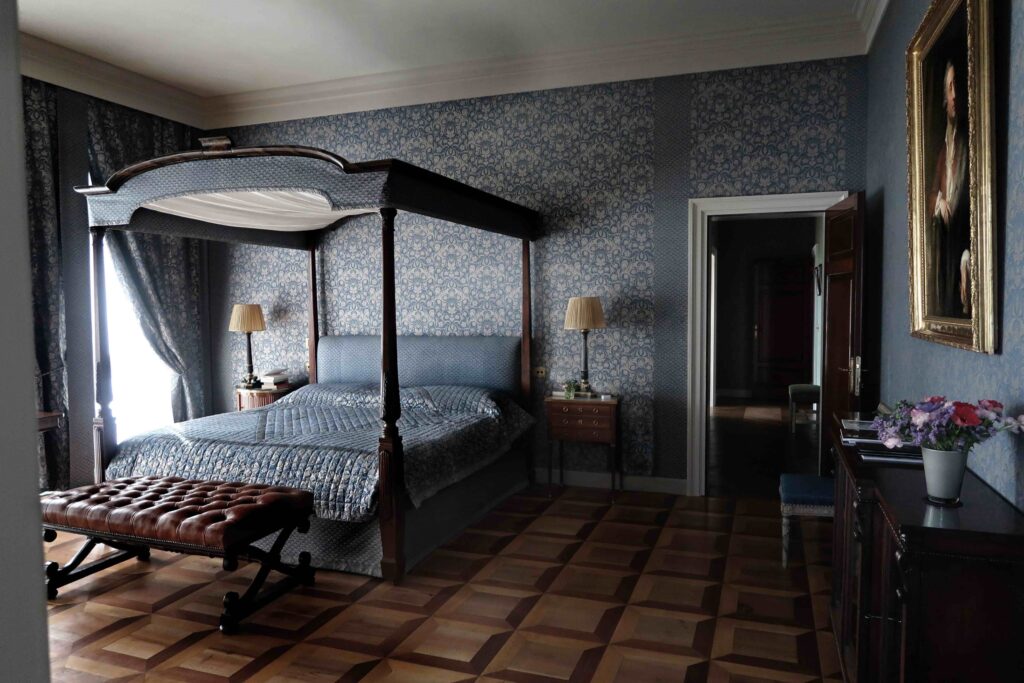
Design editor Mitchell Owens once said: “Laura Sartori Rimini and Roberto Peregalli—partners in Milan-based Studio Peregalli—are time travelers, wizards whose spells conjure the distant past. Not precise replications, mind you, but rooms where historical precedents are employed as springboards for contemporary creativity, blue-blooded decors wherein traditional craftsmanship is not only celebrated but revered. Most of all, Laura and Roberto are romantics. They ensorcel us with fairy dust and fantasias, writing three-dimensional tales that are as magnificently beautiful as they are quietly soulful.”
Interior design, according to Laura Sartori Rimini and Roberto Peregalli, my guests on last week’s Interior Design: The Legends program, is a matter of culture and philosophy. The technical aspects, the craftsmanship, and the individual elements all work in support of the larger organizing principles. This approach is overwhelmingly evident in their projects, which span three decades across the globe: New York, Tangier, Paris, London, Spain, Capri, Saint Moritz, Tel Aviv, and more. They are true masters of creating spaces that are at once intellectual and emotional, crafted to the highest standards, deeply layered with connotations and allusions, and always an embodiment the their core values.
Laura and Roberto told me at the beginning of the talk that they do not consider themselves to be legends. But to many—devotees, design writers, and experts—they certainly are. Their work exists far beyond the realm of the trendy, and you won’t find the duo on Instagram. Both of them feel strongly that if you can’t experience their spaces in person, then print media is the only appropriate substitute. The greatness of any design does not arise from stylistic character, they say, but rather only through authenticity, which is created from within like music or poetry.
The two began their careers in the atelier of another legend, Italian architect-decorator Renzo Mongiardino, and Studio Peregalli carries forward their mentor’s legacy of scholarly, couture interiors, in which imagination, narrative, and expertise are fundamental and past and present coexist in harmony. Although there is a common approach that connects all of their projects, each of their designs is distinct, tied to its particular site with its own fascinating story to tell. Each project, Laura and Roberto told me, comes with a set of challenges that inspires them to invent unique solutions in order to achieve excellence. It is clear that living in Studio Peregalli’s interiors can never be boring.
The first step to any project, according to Laura and Roberto, is to study the place—not only the site’s current surroundings and material culture but also its vanished past. This intensive research means that you are taken on an epic journey whenever Laura and Roberto discuss their projects. As you listen, you travel through their magnificent interiors into unfamiliar yet inviting geographies and civilizations. It’s no wonder their book is called The Grand Tour.
For their project in Capri, for example, Laura and Roberto discussed the legacy of architect Edwin Cerio (1875-1960), whose tenure as mayor impacted the island’s real estate development and whose villa design become became a touchstone for Capri living. Next, the duo took us to Saint Moritz to admire its singularly peaceful mountains and lakes; then on to Tangier to take in its cultural mix of East and West; old Islamic architecture tinged with French flavor.
Laura and Roberto are known for their love for craftsmanship, passion for details, and a strong vision for beautifying spaces. Yet, the client, they say, stands at the center of their work. Their mission is to distill their client’s sensibilities and connect them with their own taste. Their projects, they say, always grow from a dialogue, because the ultimate goal is to connect the soul of the home to the soul of those living in it—the client’s “metaphysical essence,” as Roberto says.
They do not like to identity of their clients, but a search reveals that they’ve worked with wife-husband artists Rachel Feinstein and John Currin, fashion legend Paolo Zegna, antique dealer Emil Mirzakhanian, and art patron Pierre Bergé. While Laura and Roberto often go shopping with their clients, they love to use what the clients already have—because objects are a part of people’s narrative.
What did we learn from Laura Sartori Rimini and Roberto Peregalli, founders of Studio Peregalli? That that the greatness is found in the details; that a house is not a museum and should be livable; and that while their work does not look provocative at first sight, their artistic process borders on the radical. This article was published this morning in Forum Magazine.







